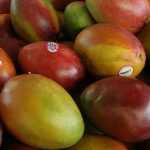
Mangoes
When to Buy/In Season:
April to September
How to Select:
Look for oval or round, orange or red fruit, sometimes with speckled skin. Ripe mangos should yield slightly to gentle thumb pressure on the skin. Unripe fruit are hard and have very poor flavor. Avoid any bruised, soft, or shriveled (wrinkled) fruit. Freckling is normal.
Organic Issues:
Organic mangoes are an issue! Conventionally grown mangoes are typically heavily sprayed with toxic chemicals, and imported from other countries. Several organic consumer groups recommend asking to see the name of the organic certifying agency, and if not available, the produce manager who certified it. Conventionally grown mangoes may have been passed off as organic, and as imported fruits, the pesticides used may be particularly toxic. This has not been confirmed by the USDA.
Pesticide Issues:
EWG 2009 Dirty Dozen, #43
How to Store:
Imported mangoes were likely picked unripe, and must be ripened prior to eating. Ripening can be aided by placing the mangoes in a paper bag with an apple; the natural ethylene gas produced by the aging apple will ripen the mango. A ripe mango will yield to gentle pressure.
Fresh mangoes will keep 1 – 2- weeks at room temperature. They may be refrigerated after ripening for 1 – 2 days.
Freezer
To Freeze Fresh Mango:
Canning
See our Basics of Canning Fruit at Home
Home Canned fruits can be stored for up to 1 year; they may lose quality after that point. Commercially canned fruit can be stored up to 3 years.
Drying:
See our Basics of Drying Fruit at Home
Dried fruit may be stored 6 – 12 months at room temperature, or indefinetly in the freezer.
Photo Source: o0Karen0o
Return to Buying and Storage Guide for Fruits


